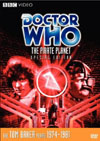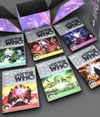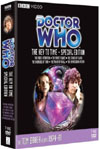Special Edition and Region 2 DVD Extras include:
First ImpressionsI believe that I began to understand the true nature of the TARDIS in this story, with the Doctor and Romana still in the control room and able to view the planet from the surface even after the blue box had materialized, not to mention all the highly enjoyable dialogue and banter about landing the craft.On the whole, the story itself dealt with subject matter, settings and characters that were far more sci-fi and interesting to me personally, and it developed in grand and surprising ways. I wholeheartedly found it to be better than "The Ribos Operation" (story no. 98). Although "Ribos" had advanced much slower along the Key to Time Quest than I had hoped, I think "The Pirate Planet" allowed me to anticipate and relish each separate adventure along the quest to a far higher degree.
TechnicalitiesIn retrospect, "The Pirate Planet" was an ambitious project for the Doctor Who production team of the time, but Doctor Who is usually at its most interesting when it stretches its boundaries like this. The production is mostly excellent, but has a few noticeable flaws.Dave Chapman is in charge of electronic effects for this one, and pulls off some exceptional soft-edged picture-in-picture mixes, not to mention great beam effects for the Mentiads, the Polyphase Avitron, and the defining style for K9's blaster. But the most numerous firings of beam weapons come from the guards' standard issue rifles, and these receive a most sub-standard red blob or diamond on the target only. This is a very poor choice for type of effect considering that about 80% of such shots fired are misses, meaning that the red blobs would belong out of frame most of the time, and leave nothing you can add in the frame itself. The DVD version of this story is unique in presenting many surviving clips of raw film footage from this story, some of which didn't make it into the finished program. Nearly all of the extra clips involve laser battles fought with the guards' rifles, this time without the red blobs. Interestingly, the plain footage seems to get the idea across better, proving that director Pennant Roberts knew what he was doing with the camera angles, and it is easy to imagine how much better the story could be with better laser effects. "Earthshock" (story no. 122) and "Revelation of the Daleks" (story no. 143) definitely do not need laser effect upgrades anywhere near as badly as "The Pirate Planet" does. This story really needs to show the beams coming out of the muzzles, and either traveling completely outside of frame for many of the misses, or being reflected off of or absorbed harmlessly by the mentiads and/or their force wall. Simply having red blobs pop up in absurdly inappropriate places detracts from the story points that the script wants to make during these battles, and needlessly adds confusion. I must add though, that I really like the sound effect for the guards' rifles, a very nice, echoing, "out-there" sound.
Clive Bennett is exceptional among the average citizens of Zanak featured in episode one, and it's a pity he is obscured in many of the crowd shots. Many of the other citizens, guards, and technicians are quite lacklustre, as are Mula, Balaton, Kimus, and Pralix during their time in the wonderfully colourful sets of their home apartment. The dialogue for them here is simply too whiney and unable to come to grips with the story points for my tastes; Pralix, Kimus and Mula fare much better once they move on to more adventurous settings. Bruce Purchase's Pirate Captain, on the other hand, is a good old barrel of fun. Having him play off of Andrew Robinson's excellent Mr. Fibuli is key to the character's success, and the hidden layers that gradually reveal the Captain's more three-dimensional aspects are much welcome stake-raising surprises. Also of note is Rosalind Lloyd's Nurse, who slowly gains much strength after an exquisitely subtle entrance.
"I save planets, mostly, but this time I think I've arrived far, far too late."Tom Baker and Mary Tamm are also in top form throughout, starting the story off with more of the great intellectual rivalry that graced the beginning of their characters' relationship in the last story. The Doctor gets to go everywhere, meet everybody, and keep very busy solving problems and remaining in jovial good spirits throughout, except quite rightly when some atrocity is revealed, so top marks on getting his character right today.This story is rather neatly split in two, with the first half going to exploration and investigation, and the second devoted to an ever escalating struggle between the Captain's forces and the Doctor's party. The escalation is extremely enjoyable, logical, and well-written, coming to a climax in episode four with all the right energy for a Doctor Who conclusion. But as this gives way to the required relief of tensions, many story points, not to mention the villains themselves, still need dealing with. Adams takes care of everything before the end, but the sense of it lies mostly in dialogue, and the final dispatch of the villains and their lair cannot match the level of excitement that the earlier struggle commanded. This is in fact the only story in the Key to Time season that doesn't show its allotted Key segment transforming back to its natural state. It seems to be a bit of an anti-climax, but the anti-climax portions are actually quite short compared with what came earlier, so the structure isn't too far off, and one can't complain too much.
International Titles:Magyar: "A kalóz bolygó"Français: (La Planète Pirate)Русский: "Планета пиратов"This story is the 2nd adventure in season 16's Key To Time quest. It has become available on DVD and VHS video. Single Story versions:
Comments on this article are welcome. You may contact the author from this page:
|
|||||||||||||||||||||||||||||||||||||||||||||||||












